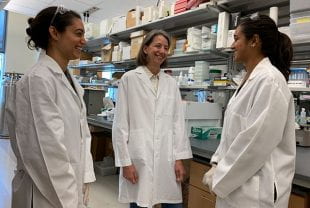Rice researchers join national fight to rapidly expand coronavirus testing
Bioengineering graduate students Kathryn Kundrod and Mary Natoli went online to order supplies for their Rice University lab late last week and were surprised to see a banner ad offering discounts for coronavirus testing materials.
“We saw the kits were available for research use at the same time that we were seeing headlines that said there was a testing shortage throughout the U.S.,” Kundrod said.
Thinking the ad might be a mistake, Kundrod and Natoli added a batch of the necessary DNA primers to their basket and found that not only were they in stock, they were available for expedited delivery. Thinking the shortage might be related to another component for the test, they confirmed that everything they’d need to test for coronavirus was in stock from suppliers.
“We could order everything,” Kundrod said. “We wondered where the bottleneck was, and that’s when we started looking into what’s limiting scale-up and capacity.”
Knowing that South Korea has ramped up to conduct more than 12,000 coronavirus tests per day, and that the U.S. had conducted fewer than 23,000 in the two months leading up to March 15, Kundrod and Natoli decided to act. With their mentor, Rice bioengineer Rebecca Richards-Kortum, they penned an editorial calling on federal officials to draft their lab and thousands like it across the country.
“We, and thousands like us, are ready to help right now,” they wrote in Wednesday’s Houston Chronicle.
What Kundrod, Natoli and Richards-Kortum and others in their group are proposing to do is similar to the work they carry out on a daily basis, but with a critical distinction: They do not work with human samples and do not have the regulatory certifications that would allow their lab to conduct tests for human patients.
They said there are shortages for some of the test materials that have been approved for clinical use by the Food and Drug Administration. The materials that they found and ordered online are not approved for clinical use but rather for biomedical research, and therefore do not contribute to the shortage of clinical-grade testing materials nationally.
“These research-grade materials are rigorously validated,” Natoli said. “I think that that’s an important piece of all of this. It’s not like these are investigational materials. They are widely used and manufactured at scale. They just don’t have the approval for clinical use.
“In a public health emergency, normal restrictions can be modified, and that’s what we’re calling for,” Natoli said. “The U.S. should scale up testing as fast as possible.”
“We should use every resource we have to fight this pandemic, and academic labs like ours are a huge, untapped national resource.”
—Rebecca Richards-Kortum
The tests would be routine for thousands of graduate students and faculty in life science and bioengineering labs across the country, they said.
“Collecting a nasal swab is not part of what we would do,” Natoli said. “That would be done by medical personnel.”
But the rest could be done in their lab and dozens like it at Rice and in the Texas Medical Center, they said. It involves three steps: isolate viral RNA from a swab, amplify a viral gene of interest and detect the resulting products. The most sophisticated equipment required is a quantitative polymerase chain reaction (qPCR) instrument.
A centrifuge is needed for the first step, but those are very common and even found in most high school science labs. The second and third steps require a qPCR thermocycler, a machine that rapidly makes copies of nucleic acids and uses fluorescent light for detection. qPCR is necessary because the amount of viral RNA on a swab is miniscule. By copying and recopying the nucleic acids, the machine amplifies the viral signal so it can be detected, typically in less than two hours.
For detection, fluorescent probes that are specific to the viral nucleic acids are used. If no virus is present, no fluorescence will be detected. In the presence of viral nucleic acids, fluorescence will increase during amplification. In short, an infected sample glows at the end of the test and an uninfected sample doesn’t. Amplification and detection are automated and happen inside the qPCR instrument, which can typically measure 96 samples at a time.
Kundrod and Natoli estimate they could each perform about 75-100 tests in 8-10 hours, and they have enough research-grade supplies to prepare for the possibility of testing. They say many others are ready to volunteer, in labs at Rice, the TMC and across the country. The next step is to understand what regulatory steps would be needed to leverage academic laboratory infrastructure.
“Testing can save lives,” Richards-Kortum said. “We should use every resource we have to fight this pandemic, and academic labs like ours are a huge, untapped national resource.”


